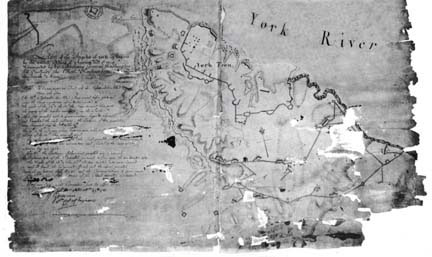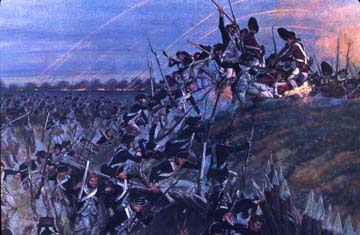 |
| British defenses and the American and French siege works at Yorktown as documented by Col. Gouvion, Corps of Engineers, ten days after the surrender, October 29, 1781. |
U.S. Army Engineers Helped Assure Victory at the Battle of Yorktown in 1781
On the afternoon of October 19, 1781, British troops marched onto the battlefield at Yorktown, Virginia, to lay down their arms before the assembled combined forces of America and France. This event capped a three-week siege in which engineers of the French and American Continental armies played a key role.
Although General George Washington’s British opponent Lord Charles Cornwallis was far outnumbered, Washington and his French allies, the Count de Rochambeau in command of the Army and Admiral de Grasse in command of the Navy, decided to undertake a full-scale classical siege. The burden of planning and executing the siege fell on the shoulders of a relatively small group. There were thirteen engineer officers in the combined armies. The American forces also included three companies of Sappers and Miners totaling fifty men, assisted by another fifty Delaware recruits. Their principal job was to dig the trenches approaching the enemy lines in parallel, zigzag formation, and clear the way during a direct assault.
 |
|
| Capture of Redoubt Ten by joint action of the engineers and infantry, October 14, 1781, as depicted by twentieth-century artist H. Charles McBarron. |
|
A highlight of the siege occurred during the construction of the second parallel. Two strong British positions, Redoubts Nine and Ten, impeded progress and had to be taken. American infantry led by a contingent of Sappers and Miners, all under command of Colonel Alexander Hamilton, successfully captured Redoubt Nine while the French took Redoubt Ten. In less than twelve hours both redoubts had been incorporated into the siege lines. The threat to Cornwallis’s position was now so formidable that he attempted unsuccessfully to escape. Surrender was inevitable.
When it was over, Chief Engineer Louis Duportail was quick to point out and Washington wholeheartedly agreed that the officers of the Corps of Engineers had contributed significantly to the outcome. Speaking with great respect for Duportail, Washington declared “his plan and conduct of the late attacks in the successful siege of Yorktown afford brilliant proofs of his military genius, and set the seal of his reputation.” Indeed the siege of Yorktown was the finest hour for American engineer officers and their troops of Sappers and Miners during the American Revolutionary War.
* * *
October 2006